Burgundy odyssey: update with monopole vineyards from Nuits-Saint-Georges
December 28, 2012
My Burgundian Odyssey in mid November 2012: update with notes from Nuits St Georges
Tasting 2012 from barrel for the Hospices de Beaune, filming Carla Bruni Sarkozy, tasting a series of superb Nuits St George monopole vineyards, dining with Bouchard Pere & Fils’s director Philippe Prost over vintages ending in “2” including a sublime Volnay from 1962, tasting through several wonderful Clos Vougeots at the Domaine de la Tour, which is getting better and better – and so much more packed into a four day visit to this magical place called Burgundy
New update featuring report on Hospices de Beaune auction and tasting notes of 2012 barrel samples
Quick links to: Hospices de Beaune auction 2012 / Tasting notes of 2012 Hospices de Beaune wines / Bouchard Pere & Fils / Chateau de la Tour Clos Vougeot / Domaine de l’Arlot / Hospices de Nuits / Jacques Frederic Mugnier / Domaine des Perdrix / Domaine Prieure Roch / Domaine Michel et Patrice Rion / Link to report on wines from Faiveley, Mugneret Gibourg, Humbert Freres, Thibault Liger-Belair, and many more!
As I pop on an old CD rediscovered in the family home in Arlington Virginia – classic tunes of Thelonius Monk – I put pen to paper or rather fingers to keyboard to begin recounting this marvelous last trip to Burgundy. Let’s start with a visit to Clos Vougeot’s Château de la Tour, an estate that had been making somewhat less than potentially good Clos Vougeot wines despite being the largest owner of that famous grand cru vineyard, with just under 15 acres, in the heart of the Cote de Nuits.
For more general information on Clos Vougeot, please read my article in France Today.
But lately, the wines have been reaching new heights of quality noticed by the wine press around the globe, from the very fine Bourgogne Aujourd’hui magazine which has a fine panel of tasters to Mr. Burghound himself who highly recommended the wine – especially the Old Vine incarnation – in both 2009 and 2010. After tasting the regular cuvee I was convinced enough to purchase a six pack of old vine 2009…
Claire Naigeon welcomed me kindly on a cool November day. A series of changes over the years has led to greater precision – and better wine. Since 2009, Sylvain Pataille has been directing operations for Francois Labet, the charismatic owner. More precision in the vineyard, parcel selections. Methods include whole berry cluster fermentation.
VIDEO OF MY VISIT!
Just eight people work for Labet, and Claire was looking forward to doing some winter pruning of the vines when she met me at the estate for a small vertical.
The name Château de la Tour refers to one of two famous buildings associated with the appellation of Clos de Vougeot. The more celebrated monastic cellar, now the headquarters of the Confrerie des Chevaliers du tastevin, is of course the other famous building.
The Château de la Tour was constructed in 1890 by a Monsieur Beaudet of Beaune, whose daughter married Jean Morin of Nuits St Georges. Morin’s daughters married into the Labet and Déchelette families, with Pierre Labet himself owning a domaine based in Beaune. Francois Labet is responsible for both the wines of Domaine Pierre Labet and Château de la Tour, made in the Château’s winery and cellars inside the walls of Clos de Vougeot.
The holding of Clos de Vougeot covers just under 5.5ha in all, including the one plot of approximately one hectare of ancient vines planted in 1910. Part of this is used for the limited edition old vines cuvee, made from parcels in the heart of the vineyard, on the upper slopes that surround the two châteaux and lie just below Musigny. The 2010 bottle includes a gold lettered mention of 100-year-old vines!
The estate is located right in the vineyard on the northern side of the Clos Vougeot, with holdings of six hectares of old vines in Clos Vougeot from which the Vougeot and a Vieilles Vignes are made (the latter hailing from vines between eighty and one hundred years of age).
I also met with Cyril Beutot, the chef de culture, who explained that extraction times have been shortened since he had arrived in 2002. “Sylvain understands how to work with whole clusters,” he added. The vine plantings are dense planting, at about 10,000 vines per hectare. But spaces between bunches are kept wide, for better aeration and better solar exposure: this had changed since 2009, Claire said. Every second bud is removed to increase aeration, she explained. Rather than green harvesting, the final expected yield is left on the vines. Grass, which helps to draw off excess moisture, is left between the rows. The vines are pruned into a shape resembling an inverted pyramid, to accentuate photosynthesis at the top.
Grapes are sorted (and not de-stemmed) to remove anything undesirable, placed as whole bunches in the fermenting vats, lightly sprinkled with sulfur, and cooled down for a week to begin fermenting on their own. The must is kept to a maximum temperature of 28-29°C and as soon as fermentation is over the juice is removed, to avoid any post-fermentation maceration which might unleash harsh tannins from the stems. The wines are then aged in barrel, using about 50% new oak for the regular cuvée and 100% for the Vieilles Vignes Cuvée, typically amounting to eight barrels worth (2,400 bottles).
Tasting young Château de la Tour Clos Vougeots is not always easy, perhaps because Labet does not believe in de-stemming, but the quality is there… and I was thoroughly impressed with the 2009. I did not get a chance to taste the 2010.
Vertical of 2007-2008-2009 Clos Vougeot regular cuvee
2007: Nose is rather floral, spicy, with light pepper notes. The palate is smooth and charming, with a fine fruit expression. But coming back to this, after tasting the 2008, it seems quite light.
2008: One can notice a deeper color already, more violet, and the nose seems “fresher” with more concentration on the palate – which seems to be evolving more slowly than the 2007. There is both more tannin and acidity. The wine looks younger than just one year compared to the 2007. It is quite suave on the palate, if tight and slightly austere on the finish.
2009: The bottle had been opened already yesterday, but the nose seemed closed at first. The attack on the palate is quite intense, followed through with a enveloping palate, with noticeable tannin of a very fine grain. The texture is matched by a fine sense of ripe fruit and structure leading precisely to a smooth and long finish. An excellent wine. I am glad I purchased six bottles of the Old Vine version, which I have not tasted… but am certain that it will be gorgeous!
Tasting of 2012 barrel samples one day before the Hospices de Beaune sale in Burgundy
Directly to the barrel sample tasting notes
With a minuscule yet promising 2012 harvest and increasing demand worldwide, it may be the right time to buy Burgundy now, before prices increase further
The Hospices de Beaune this year set near records since Christies began running the auction 13 years ago. Raising some €6m ($7.75m) – half a million euros more than last year – the 152nd Hospices de Beaune auction reflected trends in the global marketplace, with increased Burgundy sales in most all markets – including dramatic rises in Asia. In the first seven months of 2012, wine sales increased by 19% in volume and by 42% in value to Hong Kong, compared to the same period last year, and a 65% increase in volume and 39% increase in value for Mainland China.
Pierre-Henry Gagey, president of the Burgundy Wine Council (BIVB), told journalists the day before the auction that a BIVB office based in Shanghai had just been opened to set up specific training seminars for potential buyers there.
The auction was particularly lively because of the presence of former French first lady, Carla Bruni-Sarkozy.
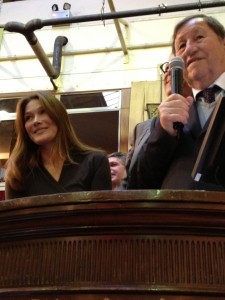
The lovely Carla Bruni-Sarkozy, with French football celebrity Guy Roux, taking bids for the President's Barrel
Star cuvees amongst the red wines included Clos de la Roche Cuvee Georges Kritter, which fetched €55,667 (94.2% more than 2011) and Mazis-Chambertin Cuvee Madeleine Collignon at €38,318 (57.7% over 2011).
All six barrels of a grand cru from the Côte de Nuits offered for the first time, the Echézeaux Cuvée Jean-Luc Bissey, sold for a €50,000 per barrel. The record sale was all the more impressive given that this year there were lowest amount of barrels under the hammer in 25 years – 516 lots were sold, compared to more than 700 last year.
This year’s President’s Lot – a 350 litre tonneau of Grand Cru Corton, Cuvée Charlotte Dumay – was bought by Ukrainian businessman Igor Iankovskyi. You can see Carla Bruni-Sarkozy in this video I took from the day of the auction, below:
Money raised will benefit the Fondation Carla Bruni-Sarkozy, which supports arts and education for disadvantaged children, and the Institut des Epilepsies de l’Enfant et l’Adolescent (Idée), which fights epilepsy in children and adolescents.
The money raised for the other lots goes to the various charities supported by the Hospices.
For as yet unknown reasons, actor Gerard Depardieu – recently given Russian citizenship as a way to avoid prohibitively high taxes of 75% that French President Francois Hollande plans to levy – cancelled an announced appearance the night before the Sunday auction. But Bruni-Sarkozy and French football celebrity Guy Roux proved more than equal to the task.
She would personally deliver the barrel if a bid reached €200,000, Bruni said. ‘And if someone bids €250,000, my husband will do it,’ she added.
At one point she encouraged journalists below the podium to make bids.

That's me tasting 2012 barrel samples one day before the auction with expert Burgundy taster Michael Apstein
I am not an expert at tasting barrel samples of Hospices de Beaune auction wines. This was only the second time I had ever done so, and it was reassuring to be with more experienced palates. Some 80 tasters from around the world gathered at the beautiful Hospices de Beaune to evaluate barrels samples of wines that were sold the next day at auction. My notes often reflect consensus opinions at my table which included Burgundy specialists Michael Apstein of Wine Review Online, Greg Love, Amanda Regan and Neil Beckett, editor of World of Fine Wine.
REDS – As you will see, some very impressive wines, some a bit spotty, but overall this looks promising…. When in bold, I liked in particular, if red and bold even more and when underlined, quite awesome!
Santeney (Christine Friedberg): Quite substantial with concentration and finesse on top. Impressive for its pedigree.
Pernand-Vergelesses 1er Cru (Rameau-Lamarosse): Here the acidity comes to the fore, leaving a very tart impression. Malolactic should resolve this… hard to make a judgment for my palate (this is the second time I am doing such a tasting!)
Savigny-les-Beaune 1er Cru (Fouquerand): Here we have a softer and smoother impression, which is positive.
Savigny-les-Beaune 1er Cru (Arthur Girard): Once again, a rather soft and pleasing impression.
Savigny-les-Beaune 1er Cru (Forneret): This seems to have the most perfumed nose, most focused albeit a more tart palate… Once again, malolactic fermentation to occur later may turn this into something special.
Monthelie 1er Cru (Lebelin): Very smooth impression, pleasing, but is the mid palate hollow?
Auxey-Duresses 1er Cru (Boillot): This is also smooth on the entry, some choppy tannin that is more foreboding than previous wines. Not sure what to think, but at this stage, seems good to me.
Beaune 1er Cru (Maurice Drouhin): This is in red and bold because the first wine to be really superb… Lovely nose, smooth and soft but substantial, revealing excellent underlying depth
Beaune 1er Cru (Hugues et Louis Betault): Here there are licorice and mineral notes, tighter on the palate, tannin is more evident
Beaune 1er Cru (Brunet): Quite soft entry and mid palate but drying on the finish.
Beaune-Greves 1er Cru (Pierre Floquet): Very tannic with a rhubarb aspect, the finish is again marked by drying tannin… Is this the result of the hailstorms?
Beaune 1er Cru (Clos des Avaux): This is quite impressive, on the powerful side, with clarity throughout and an inky concentration.
Beaune 1er Cru (Rousseau-Deslandes): This is also quite fine, rather refined, in fact.
Beaune 1er Cru (Dames Hospitaliers): Juicy and fresh and very smooth.
Beaune 1er Cru (Guigone de Salins): Also quite smooth and elegant if not as juicy and fresh as the above.
Beaune 1er Cru (Nicolas Rolin): This is better than the Volnay below, a fine impression in terms of substance.
Volnay 1er Cru (Muteau): Frank entry, smooth on the mid palate but slightly drying on the finish.
Volnay 1er Cru (Blondeau): This seems less impressive than the above, lacking substance and verve, and also touched by some drying tannins.
Volnay Santenots 1er Cru (Jehan de Massol): Just when you might think that the hail in Volnay means that all these wines are going to be difficult, you come across this wine. Deep and dark fruit nose, mineral aspects that come to the fore on the palate, which is rich and robust and juicy. Lovely barrel sample.
Volnay Santenots 1er Cru (Gauvain): More loose-knit compared to the above, with a goût de grêle as the French say when referring to a slightly off note related to hail damage. At least that is what more experienced palates explained to me…
Pommard (Raymond Cyrot): Here one can be impressed by the structure albeit a certain rusticity, chunkiness to the wine detracts.
Pommard (Billardet): Once again, we encounter a bit of drying tannin here that could be explained by the hail storms
Pommard Epenots 1er Cru (Dom Goblet): Sappy palate, medium bodied and pleasing, slightly austere finish.
Pommard 1er Cru (Dames de la Charité): What a fresh nose and smooth and lively attack! Overall impression of elegance and refinement with a long and tonic finish. Superb.
Corton Grand Cru (Charlotte Dumay): This is a bit of a letdown with somewhat bitter tannin, oak tannin? And an overall impression of being hard. Perhaps the barrel aging will resolve this, but it looks challenging.
Corton Grand Cru (Docteur Peste): Quite impressive here, with a robust quality that leaves it less refined as the Dames in Pommard but with greater power.
Corton Clos du Roi Grand Cru (Baronne Du Bäy): While the nose is fresh enough, the palate is not as impressive and even a touch hollow on the mid palate…
Echezeaux Grand Cru (Jean-Luc Bissey): This is one very impressive wine, which seems however to battle sap versus oak, but the sap – the juiciness – wins in the end. I think barrel age will turn this into something special.
Clos de la Roche Grand Cru (Cyrot-Chaudron/Georges Kritter): This is a very impressive wine for its structure and power, but will need time… Lots of potential here.
Mazis Chambertin Grand Cru (Madeleine Collingnon): Now the nose is lovely and there is a feeling of completeness to the wine, as one appreciated a medium plus to full bodied mid palate, but I could not help but notice a bit of drying on the finish – just a bit. Somewhat superficial overall when compared to the above. Time in barrel should resolve things.
WHITES – Rather hard to assess, especially the first few wines tasted… because the sugar was high, sometimes with dead yeasts in glass.
Meursault (Goureau): Quite a sugary impression here, hard to evaluate….
Meursault-Porusots 1er Cru (Jehan Humblot): Cloudy and difficult to assess, yeasts literally floating in glass… but the acidity is there.
Meursault-Genevrieres 1er Cru (Baudot): Here we have, finally, some focus.
Meursault-Genevrieres 1er Cru (Philippe le Bon): Spicy aspect and good acidity.
Meursault-Charmes 1er Cru (de Bahezre de Lanlay): This is also quite focused with good acidity.
Meursault-Charmes 1er Cru (Albert Grivault): Leaving a flabby impression.
Corton-Charlemagne Grand Cru (Roi Soleil): Quite fresh and smooth overall with an underlying substance. Medium plus palate presence and intensity and length. Nice job!
Corton-Vergennes Grand Cru (Paul Chanson): Here the nose is a bit odd. Several tasters were not that impressed.
Corton-Charlemagne Grand Cru (Francois de Salins): This is more pure on the nose and fine on the palate.
Batard-Montrachet Grand Cru (Dames de Flandres): Opulence married with verve – good acidity. The mid palate is enveloping already with a savory character and lingering finish. Excellent.
Bouchard Père & Fils: an excellent 2011 vintage and dinner, on 16 November 2012 in Beaune
Tasting through Burgundy in mid-November, I had attended the Hospices de Beaune – see here – and wrote three news reports for Decanter Magazine. In the meantime, I was lucky enough to have been invited to a special tasting of Bouchard Père & Fils 2011 wines, on Friday 16 November, guided through the tasting by Philippe Prost, the director of winemaking at this excellent negociant/producer. Bouchard headquarters are in the middle of Beaune in the Château de Beaune, a magnificent edifice constructed between the 11th and 15th centuries. The château includes vast underground, naturally cold and humid cellar space, which prevented malolactic fermentation from occurring too soon: rather common in 2011.
Owner Joseph Henriot and Prost welcomed us to a fine dinner, after we had tasted many 2011 barrel samples. After some fine hors d’oeuvres and a crisp Cuvee des Enchanteleurs Henriot Champagne (1998), we sat down to dinner accompanied by a series of vintages ending in “2” since it was November 2012. I loved a very fine Beaune Clos Saint-Landry 2002, very fresh and vinous. The next wine was an excellent Chevalier Montrachet 1992, which was particularly youthful and deep. The third wine was the weakest: an interesting but not as impressive as one would think Chambolle Musigny Les Amoureueses 1982, which seemed a bit tired. But we ended with the wine of the night: a superlative Volnay Caillerets Ancienne Cuvee Carnot 1962, which Philippe Prost describes in this video:
Notes on Bouchard Pere & Fils 2011: the wines in bold I liked in particular, when red and bold even more and when underlined, the very best.
First off, some brief comments on the vintage. Coming off two excellent vintages – for different reasons because 2009 was a solar vintage while 2010 a cooler yet finely ripe vintage, with more verve – the 2011 may end up being underrated by the wine press. Especially because 2012 promises to be of great quality, too.
What happened in 2011? A hot, precocious Spring – abnormally hot and dry – promised an early harvest, as the bud break came very early. Flowering however was complicated by wet weather that resulted in coulure – or shattering – which means a failure of grapes to develop triggered by cold, cloudy and/or rainy weather or very high out-of-season temperatures. Some flowers stayed closed and were not fertilized. July was damp and there was a potential for rot in the vineyard, but from mid-August the weather became better, especially from 26 August, when dry weather and some northern wind stopped any rot from spreading. If the vintage is precocious, the hang time proved nonetheless long – about 110 days from flowering to the start of the harvest on 29 August – so that, for the grapes that did ripen, the ripening was even and of good quality.
According to Prost, sorting table work was required for the Pinot Noir. Bunches were unevenly ripe, with berries of different sizes and of different levels of maturity: millerandange was the word of the vintage, with some very small yet concentrated berries promising good quality. While the yields for Pinot Noir were lower than average, the Chardonnay was harvested at an average yield and there seemed to be less uneven ripening of bunches. Glancing at climate graphs, it is striking to note the following: far more sunlight than average in April and May, but slightly less than average in June and July, followed by average sunlight in August and September. In terms of precipitation, far lower than average in April and May, far more than average in July and most of August – and a dry and warm September…
REDS – Enfant Jesus is my overall favorite.
Savigny Les Beaune: Aged in about 15% new oak for some 10 months, this wine was quite ripe and seemed to have fine freshness, in spite of Philippe saying that it is a wine to drink before the 2010. Yes, I thought the palate was just a touch warm, but it did not detract from the charm and pleasure it exuded. Perhaps a bit like the 2007 vintage, but better.
Beaune Clos de la Mousse: A monopole vineyard of 3.36 hectares purchased by Bouchard in 1872, it has a walled enclosure. More oak here – up to 50%, with longer aging. I detected the oak influence but there is a lot of material on the palate. Early days! The overall impression is of dark fruit – but then I get some warmth, again. If anything, the warm aspect is more present here, with a finish that is just a touch hard. Still, there is pleasing roundness on the mid palate. Give it time to come together?
Beaune Greves Vigne de l’Enfant Jesus: A legendary vineyard belonging to Bouchard since the late 18th century, the name came from a likely apocryphal legend of a nun predicting the birth of Louis XIV even though his mother Anne of Austria was supposedly sterile. Well, whatever. The 3.92 hectare vineyard is located in the center of the Greves slope of clay and fine, gravely limestone, with an ideal south/southeast exposure. Very careful selection here paid off, because the wine exudes a genuine richness on the palate preceded by perfumed aromatics that endear one immediately. The overall texture is velvety, fine velvet, with excellent balance between acidity and alcohol and tannin. Really very successful here.
Volnay Clos des Chenes: Bouchard owns about .85 hectares of this vineyard, not far from Taillepieds. Clay-limestone over limestone with a southwest exposure. Here we have evident floral, rather violet, aromatics. Promising start. Interestingly, the acidity seems more present here than in the preceding wines, albeit with fine sap on the mid palate ending with a structured and even somewhat hard finish. Are the tannins just a bit on the hard side? This shows promise but not the magnificent balance or fine texture of the previous wine.
Le Corton: I have always loved Le Corton by Bouchard and this is no exception. The 3.55 hectares enjoy a perfect south/south-eastern exposure and in 2011, the high location was beneficial, said Prost, because acidity was preserved. Just over 50% new oak. Although in the end, not as impressive as the Enfant Jesus, this wine has a perfumed nose, good sap on the palate, marked also by fine freshness and ripe red fruit expressions. Perhaps the depth is not as impressive as it was in 2010 or 2009, but the fresh finish is very pleasing.
Nuits Saint Georges Les Cailles: Just over one hectare belongs to Bouchard from this rather small vineyard in the southern part of Nuits St Georges. A terroir of fine rounded limestone rocks with south-southeast exposure. About 50% new oak. This showed a deep nose, with a darker fruit profile and a touch of spice. There is a bit of toughness here – some of the harvest was not de-stemmed – but the raw material is there for aging. Give it time.
Chambertin Clos de Beze: Opulence on the nose precedes an enveloping yet subtle palate, although the structure is showing quite a bit at this baby stage – is it a touch harder than 2010 or 2009? Perhaps. Prost said he used less new oak this year than in the two preceding vintages. Going back to the nose, one is impressed by its incredible depth and richness – and the palate improves with time in glass. A serious wine.
WHITES – Here we see more regular success: it was harder to pick out a favorite…
Bourgogne: This is surprisingly good. Aged in 60% one year old oak and 40% steel tank. This is not over-rich, the freshness factor is excellent exuding red and green apple. A thirst quenching aspect and a frank attack follows through on a straightforwardly pleasing mid palate and fresh finish. This should be a bargain.
Beaune Clos Saint Landry: Bought in 1791 by the Bouchard family, a lesser known monopole vineyard of just under 2 hectares, this is an under the radar white worth seeking. No more than 15% new oak aging. Nose is quite herbal, grassy even, with green apple and a touch of pink grapefruit – a nice nose! The palate is smooth, perhaps it could use just a bit more zing, but it is fine.
Meursault Les Clous: I recall buying this often when I worked as a sommelier for The Chanticleer on Nantucket Island. It is always a good deal. A rather large parcel belongs to Bouchard (8.64 hectares out of 18.4), the wine is aged in at most 15% new oak. The nose here is a bit closed, rather inexpressive at first. Is this in a slightly reduced state? The wine over time displays richness, with good balance between acidity and fruit, but I feel that this vintage is not as precise as 2010.
Meursault Les Perrieres: The doctor Lavalle in 1855 classified this premier cru as the first of all the firsts… if ever there is a Meursault to be considered a grand cru it would be this 12 hectare limestone vineyard of which Bouchard owns one-tenth. A very inviting nose, deep and aromatic. The attack is bold and the palate is enveloped by opulence that has fine tension, marked by red and green apple and a touch of warmth on the finish, but overall this is delicious wine. Promising.
Corton Charlemagne: Let’s address the legend here… Traditionally a red wine vineyard, Emperor Charlemagne appreciated Chardonnay planting so that the white wine did not leave red spots on his beard. Bouchard is the third largest owner of this legendary vineyard and its Corton Charlemagne is consistently delicious, so no surprises in 2011: Light butterscotch, citron energy, ashes minerality – talk about complex aromatics. There is lovely tension, vibrancy on the attack through to the mid palate which remains vivacious and ripe through to the lingering finish. An intriguing spice also pleases the taster here.
Chevalier Montrachet: The master of Montrachet according to legend shared his lands with his two sons, the first became a knight or Chevalier during the crusades, and the second – illegitimate – a bastard or Batard. Both are great terroirs! But I like the northern cool climate Chevalier, which succeeds in warmer vintages. In 2011, a rich and iodine nose introduces a very purely mineral palate marked with some exotic notes like Kiwi fruit. What is particularly impressive here is the precision, a fine line of flavor that stays on your palate from start to long finish. Prost believes that 2010 is richer while 2011 is more classic. A success in any case. Bravo.
Chevalier Montrachet La Cabotte: A prestigious part of Chevalier Montrachet – just .21 hectares – that is closer to the Montrachet vineyard and is named after a shady area often used by harvesters to eat lunch, protected from the sun. The wine is more impressive than the preceding wine with a deeper color, a bit more headiness, and higher intensity. Although no new oak was used, if I recall correctly, at least for this sample, the wine is very opulent and has vivacity as well. Another success in 2011.
Montrachet: Just under .9 hectares, acquired by Bouchard in 1838, this is part of the great Montrachet vineyard that counts just about 8 hectares. The 2011 was aged in 17% new oak, and reveals sublime tension on the palate – I noted the phrase “this is liberating” whilst tasting it – with superb opulence and profound layering on the palate. Compared to the La Cabotte, far better tension and “contained energy” with a lovely precise minerality throughout. A great success.
Monopole vineyards tasting of Nuits St Georges
While in Burgundy in November 2012, I also enjoyed a particularly interesting tasting at Domaine de l’Arlot: a tasting of monopoly vineyards of Premeaux. The notion of Monopole – or, single estate vineyard – appeared in the Burgundian wine growing area in the 19th century. It refers to the growing and selling of a single vineyard wine recognized by the AOCs (wines of controlled origin). They may be grands crus. They may be village wines. The most famous is Romanee Conti, but others are also well known, such as Clos de Tart and La Grande Rue (actually a recent – and rare – conversion to grand cru, back in the early 1990s). As grand cru monopoles, these last two also have the same named appellation. Clos Vougeot was in fact a monopole until the late 19th century.
The Nuits 1er Cru single estate vineyards are regrouped in the southern slope at Premeaux. Some impressed me more than others, but it was a great tasting because I met the owners or the estate representatives as well as other wine lovers and people in the trade.
According to Burgundy expert Clive Coates: “The appellation of Nuits-Saint-Georges divides neatly into three parts. North of the town the vines continue up to Vosne-Romanée; Nuits’ Boudots marches with Vosne’s Malconsorts. South of the town lies the heart of Nuits-Saint-Georges, which includes the climats of Pruliers, Poirets (or Porrets), Cailles, Vaucrains and Les Saint-Georges itself, after which the commune takes its suffix. South of here, the commune comes to its end, but the wines of its neighbour, Prémeaux-Prissey, are entitled to be called Nuits-Saint-Georges. This is the third sector. Strangely, much of this area consists of monopoly vineyards. The wines neither have the finesse of those of the northern part of the appellation, nor the concentration of the middle section, but they have no shortage of depth. They also show the advantage of the individuality that comes from their being monopolies and made on a larger scale than some of their counterparts to the north.”
All I can say is that, based on this tasting, and on the vintages made available to us – 2004 was a poor choice from JF Mugnier, for example – I really came away liking in particular Domaine de l’Arlot, Domaine Michele et Patrice Rion and the Hospices de Nuits Nuits St Georges
Tasting notes (when bold, I liked particularly – red and bold, even more – when underlined, too, the best)
Domaine de l’Arlot Clos des Forets Saint Georges 1er Cru
2009: This I found excellent. Why? Deep without being heavy. Red fruit charms blends with a darker fruit profile on the palate, which shows fine structure and extraction, marked by a pleasingly tonic finish leaving you thirsty for more.
2008: Fine depth here. Richness, too, with a sensation of dry extract. Mid palate juiciness pleasing. A touch austere on the finish? But overall, a fine expression and delicious.
1999: Here a bit tough overall, but there is a lot of substance. Could it require further aging? Unsure…
Domaine de l’Arlot Clos de l’Arlot 1er Cru
2009: Friendly and juicy, similar in profile to the above, although I recall being more impressed in 2009 with the Clos des Forets Saint Georges…
2008: Red fruit. Has more body and contour than the JF Mugnier of the same vintage, it seems to me. Very good definition of fruit albeit with a touch of austerity. But the finish retains juiciness, perhaps more successfully than the Clos des Forets. Going back and comparing with other wines tasted, the Rion 2010 (see below) is better.
1999: I was just amazed at the quality of the 1999. A pretty baked cherry aspect, tertiary truffle as well. The palate is juicy, with truffle overtones, but vinous and lively. There seems to be just a touch of tough tannin on the finish but this is quibbling. The wine was my favorite of them all!
Hospices de Nuits Nuits St Georges Les Didiers 1er Cru
2009: Rich and full nose, “amazing,” I wrote. Mid palate juiciness, “sexy” I added. A touch of tannic austerity on the finish, but this is still quite young…
2008: Chunky nose. A good initial nose. The palate is rich enough, actually one of the better 2008s. Some metallic aspects. Is it a touch drying on the finish? There is good sap on the mid palate.
1999: Slight metallic. But the palate is savory and delicious. Not as good as Clos de l’Arlot, but still a very smooth 1999.
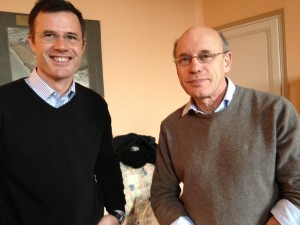
Two great Burgundy producers: Jacques Devauges of Domaine de l'Arlot (at left) and Frédéric Mugnier of JF Mugnier
Jacques Frederic Mugnier
One of my favorite domains in Chambolle Musigny, but Frederic has a monopole vineyard in Nuits St Georges too. A very fine one, in fact. But the vintages made available were not overall as appealing as those made availlable by other estates at this tasting…
2009: I have three bottles of this one. This seems to have a lot of heady fruit, much opulence and juiciness. Perhaps not quite as elegant at the previous 2009 tried? Is there a certain “modern” aspect? Freshness on the finish reassures.
2009 (white): A touch buttery but good.
2008: Lovely nose of mineral and stone promises greater refinement. But the palate is somewhat paltry and wall flower like… not sure about this!
2008 (white): Here a fine success with white peach, refinement, and a medium plus palate presence and intensity. Confirms notion of 2008 being quite successful for whites.
2004: There is an underripe aspect here and drying tannin on the finish… Not very inspiring.
Domaine des Perdrix Nuits Saint Georges Aux Perdrix 1er Cru
2009: Rich and savory nose albeit somewhat fig like. Is there also some toast from the oak? Acidity is also elevated to balance it out, but seems a touch disjointed and somewhat drying on the finish…
2008 Les 8 Ouvrees: A more inviting nuanced nose, with juiciness on the palate, seems to have a fine finish.
2008: Similar to the above, but dries out on the finish…
2002: Noticeably older color. There is sap but also hard tannin.
Domaine Prieure Roch Nuits St Georges Les Clos des Corvees 1er Cru
2009: Rich and succulent albeit not so refined. There is pleasure to be had here, but a certain rustic aspect prevents me from being more enthusiastic!
2008: The nose is somewhat neutral, and the palate exudes tobacco leaf and forest floor. The mid palate is juicy enough but somewhat drying tannins are worrisome.
1999: Once again, a certain rustic aspect to this vintage, too, which seems to be nonetheless ‘holding its own’. But not one of the top 1999s on display at the tasting.
Domaine Michele et Patrice Rion Nuits St Georges Clos Saint Marc 1er Cru
2009: Rich and ripe nose. The palate is also a pleasure, with medium plus intensity. No heat here. Structure is adequate, so it seems to have staying power, but delicious today!
2008: A more subtle nose? Mineral and silex aspects. The palate is straightforward with a fine extraction of tannin. Not drying! Nicely done!
2006: Licorice and mineral aromas. Vaguely asphalt? Lovely juiciness, a plenitude on the palate with a fine and lingering finish that may have just a small touch of dryness, but that is quibbling.

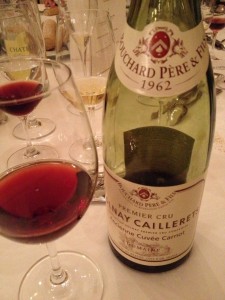
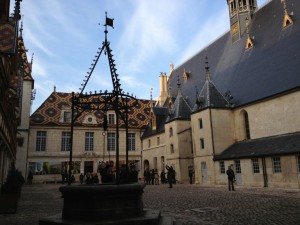
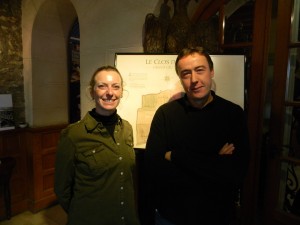
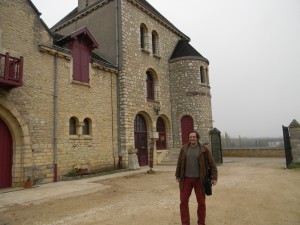
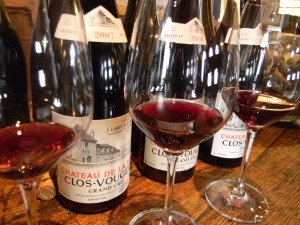
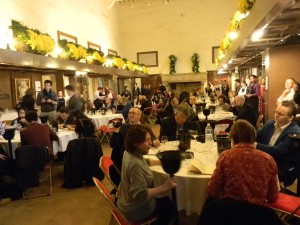

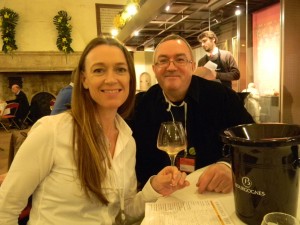
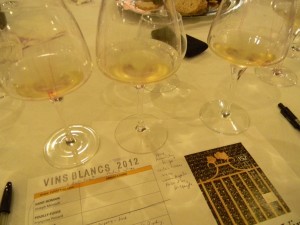
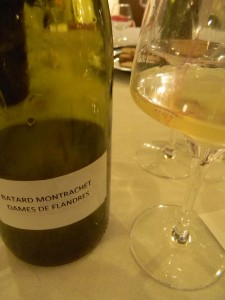
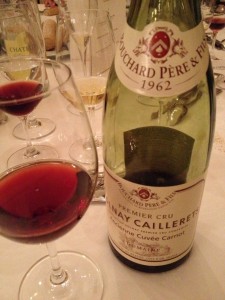
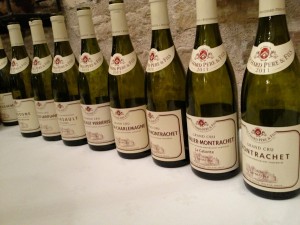
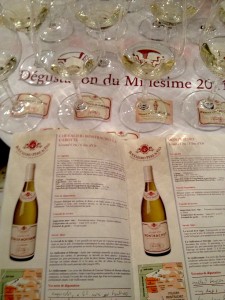
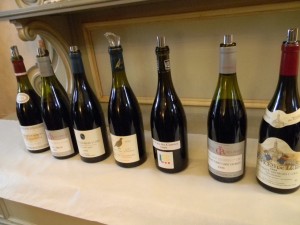
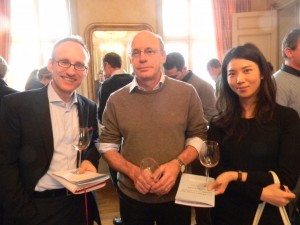
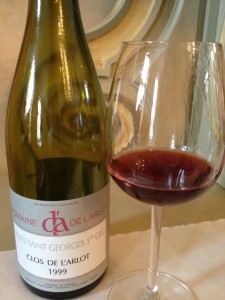
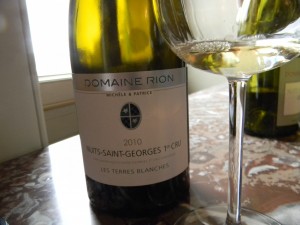
[…] I was there in November 2012 for a tasting of Nuits Saint Georges wines: here the tasting notes. […]